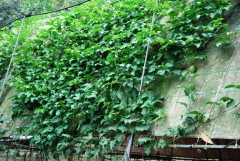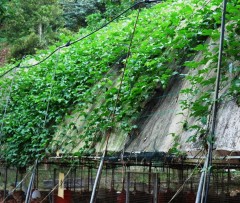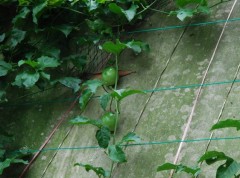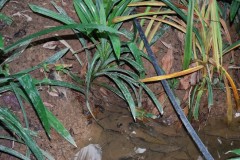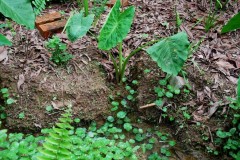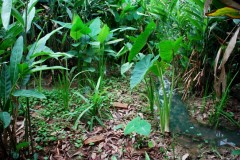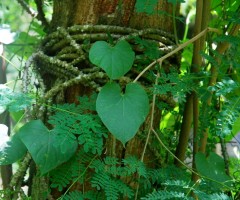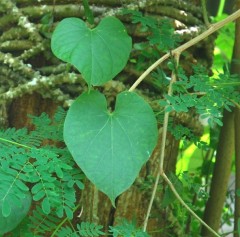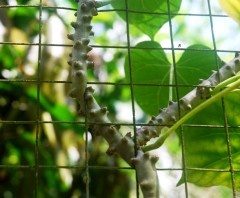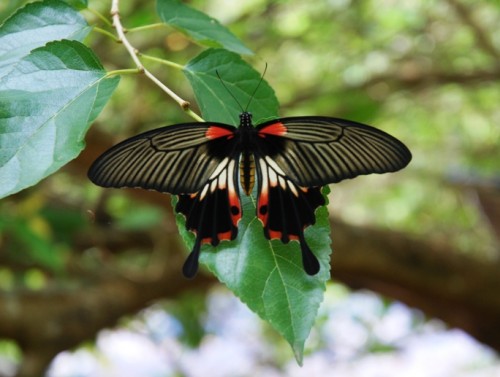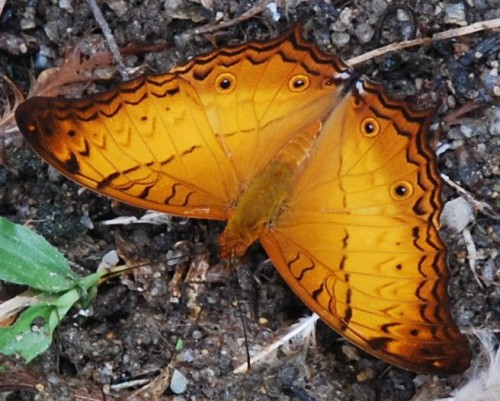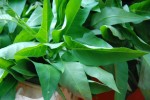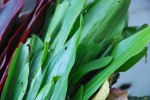Dec 24, 2010
Energy Free Cooling (Sun Shading For Rebans)
West side sun shading leading to energy free cooling via passion fruit vines at our farm:
Plastic coated wires to act as support for the vines.
External ambient temperature, 38 celcius at 2 to 3pm. Under the passion fruit shade, 31 to 32 celcius.
18:15 Posted in Blog, Permaculture | Permalink | Comments (0) | Tags: energy free, sun shading, passion fruits, permaculture cooling, chicken coop cooling
Nov 28, 2010
Pandans and Keladi - Permaculture way
Most farms in Malaysia would have earth drains. Earth drains are cheap and quick to construct and allow rain water to seep into the earth as it makes its way to the rivers. Meander the drains to give the water even more time to infiltrate. It is one way to reduce flash floods during heavy downpours. Properly positioned earth drains will reduce erosion especially during our heavy monsoon down pours.
Pandan alongside an earth drain
One way to fully utilise the nature of earth drains is to plant water loving food plants along its course. To prevent the plants from blocking the flow during heavy downpours, we just add little inlets along the sides and in this instance, plant pandans (pandanus amaryllifolius) and keladi (colocasia esculenta ) in the inlets. The only maintenance is to quickly replant new shoots to prevent a clump from being formed (which will block the drains).
A plantlet quickly inserted into a new inlet to prevent clumps from being formed
Pandan leaves are used in aromatic Asian cooking and are always in demand by buyers.
Keladi being planted in inlets along the earth drain
Keladi tubers (taro) fetch a good price. At our farm, we grow the keladis with zero input - no pesticide, no fertilisers, etc are needed. When keladis are grown in wet earth, the tubers are twice the size of those grown on soil and watered.
Keladi producing edible tubers with zero maintenance. The picture shows permaculture features like mulching, companion planting, avoidance of monoculture, and fitting food cultivation to the character of the land, here, land with high water table.
More keladis and some edible ferns, which also love water.
17:27 Posted in Permaculture | Permalink | Comments (0) | Tags: pandanus amaryllifolius, colocasia esculenta, daun pandan, keladi, yam, taro
Nov 23, 2010
Useful Plants At The Farm - Patawali
Patawali is a climbing vine and can be planted wherever there's free vertical spaces
This is one of the most useful plants at the farm - patawali or tinospora crispa.
In Vietnam it is called the "vine with a genie's intelligence". In the Philippines, it is called, "to give life".
The leaves can be used as an insect repellant
At our farm, the plant has certainly given life to many an animal with indeterminate debility health problems and fevers. We have been successful with a dosage of about 0.07 grams of the stem per kg body weight for chickens and 10 grams for a goat of about 40 kg.
The stem is used for treating animals
We use this plant also as an insect repellant specifically for mites, aphids and hoppers.
To use, chop finely the leaves and spread around newly planted chillies and other vegetables to prevent insects from spreading viruses such as those that cause chilly leaf curl, at an early stage. Repeat every 5 days.
To make a spray, extract the active ingredients by fermenting the leaves and chopped stem in a solution of your own lactobacillus brew or if you don't have any, then EM is fine. After 14 days, sieve and dilute 1:500 times (can be stronger but watch out for the acidity) and spray on plants to get rid of the target insects.
A DQ discovery; as a mosquito repellent, just pound or blend some stem, filter the juice, and apply on bare skin. It has a pleasant herby aroma. Let dry and you will be mosquito free the whole night (with the possibility of reducing skin mites, and also, skin repair due to its antioxidant content). No necessity for toxic pesticides, or genetically modified mosquitoes. The juice can be kept in the fridge for weeks, making it convenient to use.
We also use this plant as an immune booster for ourselves when we feel under the weather.
(Malaysians interested in planting patawali for use as a natural mosquito repellant can write to me for cuttings for free. You pay for the postage though, or pick it up. Email us at hs_wong33@yahoo.com).
18:19 Posted in Useful Plants | Permalink | Comments (2) | Tags: patawali, tinospora crispa, tinospora rumpii, natural insect repellents, organic insecticides, organic miticides, mites, aphids, thrips, makabuhay, day than thong
Oct 22, 2010
1Hijau.tv came to shoot a short
A film crew from the Ministry of Energy, Green Technology and Water came to shoot a short for their internet tv, 1hijau.tv.

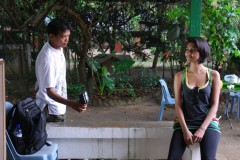

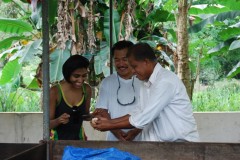
18:19 Posted in Blog | Permalink | Comments (2) | Tags: kettha, 1hijau.tv, ministry of energy
Oct 20, 2010
The Star - Write up on organic farming
I was interviewed by The Star on grass fed chickens. I am surprised at the amount of interest generated by the presence of excessive omega 6 in intensively farmed poultry and other meats world wide (this includes organic chickens fed a diet exclusively of grains, albeit organic grains. Hence, grass fed chickens are 'beyond organic').
I have been singing this song since 2001 and to my mind, it is passé but apparently not. I am surprised people are only now becoming aware of the dangers of excessive omega 6 in our diet.
Here are the links to The Star:
http://thestar.com.my/lifestyle/story.asp?file=/2010/10/1...
http://thestar.com.my/lifestyle/story.asp?file=/2010/10/1...
http://kuali.com/news/story.aspx?file=/2010/10/19/ku_feat...
A couple of erratum in the articles:
1. Omega 6 is not a cholesterol. It is an essential fatty acid which our body cannot manufacture and as such is needed in our diet. However excessive omega 6 can pose health problems, especially if excessive omega 6 is part of daily diet as is the case with the modern Malaysian diet.
2. In the old days, ayam kampung takes 6 to 7 months to reach table weight, not 60 to 70 days.
Here's a link as to how excessive omega 6 in farmed freshwater fish raises health concerns:
http://www.sciencedaily.com/releases/2008/07/080708092228...
The concern applies equally here in Malaysia.
Jo Robinson, New York Times best seller author, started the popular awareness about the dangers of grain fed, industrial animal husbandry through her book, Why Grassfed Is Best! and Pasture Perfect. Her website is a store house of information, www.eatwild.com
09:55 Posted in News Articles | Permalink | Comments (1) | Tags: the star, organic farming articles, news articles
Sep 24, 2010
Celebration of a life well lived
I write this blog to celebrate life; that there is to be found the work of God ( Stephen Hawking's latest book, The Grand Design, notwithstanding ), and the love of God for us everywhere, in the rainforests, in trees, in birds; everywhere.
And in wonderful people like Lechimi Raman; of humble birth and humble upbringing but of the noblest of spirit.
As I am honoured to know the rainforests, the birds, the magical plants in the jungle, so too am I honoured to have known Lechimi Raman.

It is de riguer nowadays to put the blame for youths who turn out badly on the environment, on poverty, on physical deprivation, and a host of other external reasons.
Lechimi brought up 5 sons, singlehandedly, in the most difficult of circumstances.
They completed their tertiary education, became well balanced, loving human beings despite their deprived background, and grew to become role models for all those who know them or hear of them. That is the legacy of Lechimi; that no matter the adversity, one continues to strive, one continues to do the best one can, with no blame or anger or bitterness in the heart towards anybody or anything.
I remember days spent in her humble home, and enjoying her curries and her fried curried fish. After a long day of rugby, my hungry friends and I would wolf down an entire week's provisions I am sure, but she will always be topping up, always with that warm, open, motherly smile of hers; happy that her son's friends are enjoying her cooking.
I remember well her love for us all. We were her children as well; and yes, I have had a couple of smacks from her.
Though time and distances have caused memories to fade, nonetheless the heart never forgets.
Thank you Lechimi, for being there for us in our growing up years. We all grew up well, and you were part of the reason why.
May you rest in peace.
10:34 Posted in Blog | Permalink | Comments (0) | Tags: lechimi raman, krishnan tan, velayuthan tan, ijm plantations, ijm corporation bhd.
Sep 12, 2010
Sanctuary for butterflies II
Our efforts to attract butterflies to the farm are showing results.
We noticed many new species lately, but it is not always possible to take a photo due to our limited equipment.
Here's a Common Rose Swallowtail that came and perch itself above our heads while we were having lunch.
Common Rose Swallowtail (Atrophaneura Pachliopta)
It's a beauty and behaves very nonchanlantly in the presence of humans.
Here's a Cruiser ( Vindula dejone erotella ):
16:32 Posted in Blog | Permalink | Comments (1) | Tags: raja brooke's, birdwing butterflies, common jay, trogonoptera brookiana, aristolochia foveolata, common rose swallowtail, atrophaneura pachliopta
Sep 04, 2010
Superfood from our forests
The latest craze in the US is black rice, touted as a superfood because of its high anthocyanin content. Here's an article from Yahoo! News.
Wait till these direct sales marketers and health food companies get hold of our black kunyit.
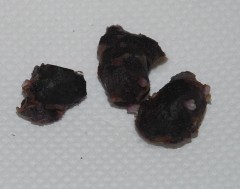

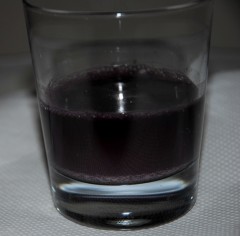
NOTE 22/7/2012 : TWO READERS OF THIS BLOG, ONE FROM HAWAII, AND ANOTHER FROM LANGKAWI, PAK DIN, http://herbwalk-langkawi.com.my/thewalk.html HAVE IDENTIFIED THIS PLANT AS Kaempferia parviflora, A PLANT FOUND IN NORTHERN THAILAND AND USED EXTENSIVELY FOR TRADITIONAL MEDICINE. THANKS TO BOTH FOR HELPING OUT.
THE PLANT WAS FOUND IN A FOREST NEXT TO OUR FARM. WE TAKE NOTE THAT THE FOREST IN QUESTION IS BOUNDED ON THREE SIDES BY FARMS AND ON ONE SIDE BY A FOREST RESERVE. WE CAN ONLY SPECULATE HOW IT WAS INTRODUCED INTO THE FOREST, THOUGH WE MUST ADMIT IT SEEMS EXTREMELY WELL ADAPTED TO THE CONDITIONS LOCALLY AND WE HAVE NEVER SEEN ANY DISEASE AFFECTING THE SAID PLANT.
11:04 Posted in Useful Plants | Permalink | Comments (2) | Tags: black turmeric, kunyit hitam, temu hitam, kali haldi, curcuma aeruginosa, curcuma caesia
Aug 19, 2010
Natural Flowering Enhancers
We use what's in the farm to make our own flowering enhancers. Our dragon fruits never stop flowering and producing fruits. Our durians can be fruiting two to three weeks before others.
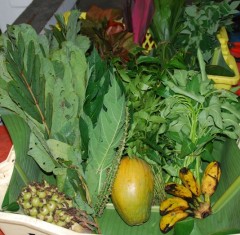



papaya 2.5
banana 2.5
Red Leaves 1.0
Kangkung young leaves 1.0
Acasia young leaves 1.0
Molasses 2.0
Quarry dust sprinkle
Put in a container until half full (or half empty, whichever). Leave for up to 60 days, covered loosely, before proceeding.
There are a few variations to use the above (which we shall call the Mother). One way is as follows:
Dilute adding 1 part filtered Mother, 1 part molasses to 20 parts water to make a Concentrate. Let the Concentrate sit for up to 7 days before diluting further required amount to use. Add one part Concentrate, one part molasses and 50 parts water for Spraying Dilution. It goes without saying you must always use unchlorinated water.
Do not spray direct from Concentrate on plants. They may wilt. Always spray diluted. Not recommended for ornamentals.
If you are using compost tea, add one part filtered Mother to 20 parts tea, and spray. Use only on fruit trees (including pitaya).
Email me direct if you encounter problems.
Notes:
1. You can find the acacia tree being grown along highways. You can use the young leaves from young trees. Acacia is an invasive, so don't plant it in your farm unless you have the patience to continually weed out the young trees.
2. Any red leaves will do.
17:45 Posted in Bio Nutrients | Permalink | Comments (6) | Tags: nature farming, organic farming, qi, qi farming, flowering enhancers, penggalak bunga
Quality Control Inspection
Officers representing the Crop Quality Control Division of the Ministry of Agriculture came on short notice to audit the farm today. Water, soil and plant samples were taken.
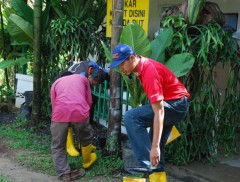

16:34 Posted in Blog | Permalink | Comments (0) | Tags: skim organik malaysia








